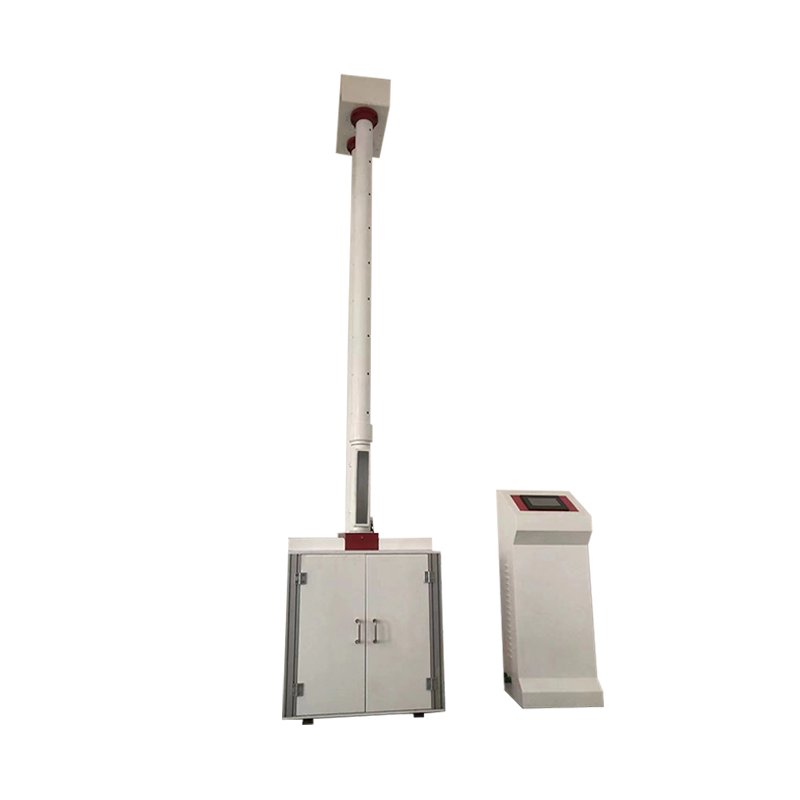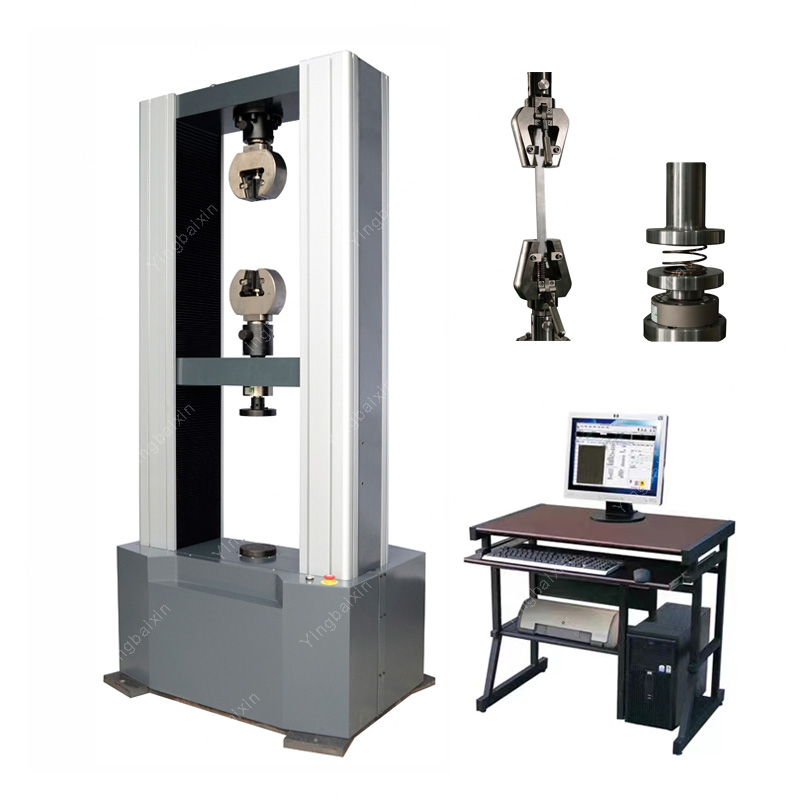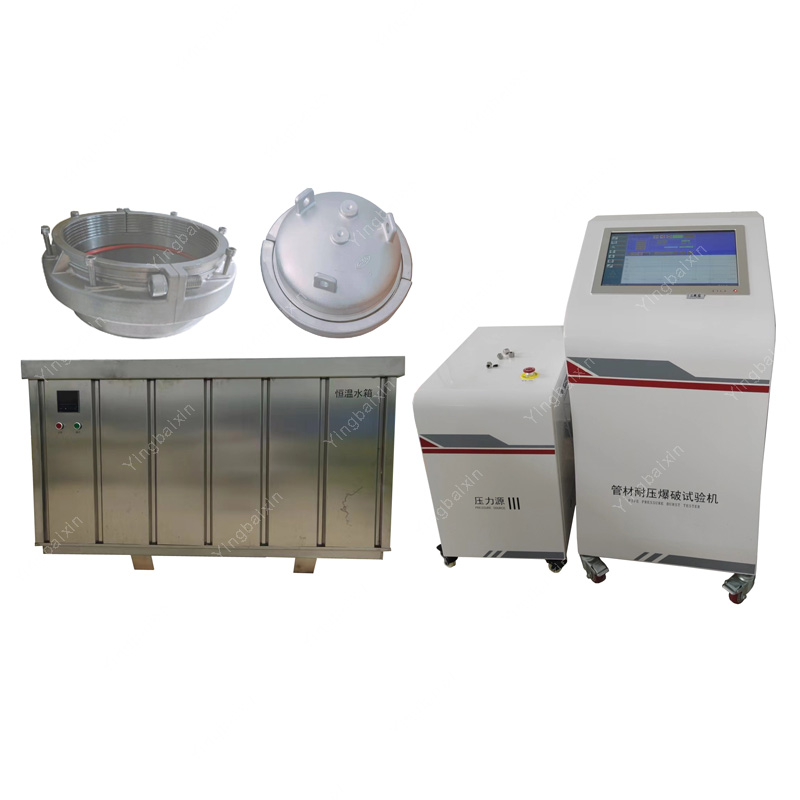PRODUCTS
XJCJ-500M Pipe Drop Hammer Impact Testing Machine
Ⅰ.Product Introduction
Applicable to the determination of impact toughness of pipes such as PVC-U, PVC-C pipes, PP pipes, PE pipes, and plastic pipes for underground communication pipelines. It is an ideal testing instrument for testing, production units, building materials industry, and scientific research institutions.
Ⅱ.Instrument characteristics
The testing machine has the function of preventing secondary impact, adopts an AC servo system, has fast lifting speed, good positioning accuracy, high testing efficiency, low air resistance, and can automatically measure the height. The lifting height of the hammer can be set arbitrarily, the lifting height of the hammer can be automatically calibrated, the weight of the impact hammer can be assembled through weights, and the capture rate of the anti secondary impact device is 100%. The V-shaped iron is adjusted to adapt to samples of different pipe diameters, and the hammer falls into free falling motion, According to the order requirements, impact hammer bodies that meet other standards can be provided. The hammer release device and anti secondary impact device are achieved through pneumatic transmission. Two testing methods are applicable: the pass-through method and the gradient method. Using high brightness (LED) digital tubes to display real-time height; The lifting height of the hammer can be set arbitrarily, and the impact height can be set arbitrarily within the range of 50mm to 2000mm
(The capture rate of the anti secondary impact device within this height range is 100%);
Automatic height calibration for lifting;
The weight of the impact hammer can be assembled using weights;
The capture rate of the anti secondary impact device is 100%;
V-shaped iron is adjusted to adapt to different pipe diameters and plate specimens with varying thicknesses. After selecting special accessories for safety helmets, impact tests on safety helmets can be conducted;
The falling of the hammer is a free falling motion (without the introduction of frictional force);
Can provide impact hammer bodies that meet other standards according to order requirements;
The anti secondary impact device adopts pneumatic capture;
The sample room is connected to the laboratory, and the temperature is the same as the test environment temperature;
Ⅲ. Compliant with standards
Ⅳ.Working principle
The true impact rate of the batch (or continuous extrusion production) of products can be measured by using a drop hammer of specified quality and size to impact the specified part of the test sample from the specified height. This test method can meet the technical requirements of different products by changing the mass or height of the falling hammer. The maximum allowable TIR value is 10%.
True impact rate:
When testing the entire batch of products, the actual impact rate is obtained by dividing the total number of impact failures by the total number of impacts, expressed as a percentage.
Destruction:
When observed with the naked eye, cracks, cracks, or breakage of the sample caused by impact are considered as failure. Dents or discoloration of the sample caused by drop hammer impact are not considered as failure. Main frame and guide rail:
Vertical fixation allows for adjustment and free release of the hammer. During calibration, the rate of impact of the hammer on the pipe should not be less than 95% of the theoretical rate.
Hammer body:
The hammer body should comply with the provisions of Tables 1 and 2. The hammer head should be made of steel with a minimum wall thickness of 5mm. The surface of the hammer head should not have visible defects such as dents or scratches that affect the test results. Hammers with masses of 0.5kg and 0.8kg should have a d25 type hammer head, and hammers with masses greater than or equal to 1kg should have a d90 type hammer head.
Sample holder:
Including a V-shaped support plate with a 120 ° angle, its length should not be less than 200mm, and its fixed position should be such that the vertical projection of the impact point of the hammer is within 2.5mm from the centerline of the V-shaped support plate. During arbitration inspection, a lead screw or bracket is used for top support.
Release device:
The hammer can be dropped from any height of at least 2 meters, which refers to the height from the surface of the specimen, accurate to ± 10mm. There should be a device to prevent secondary impact of the falling hammer, and the rebound capture rate of the falling hammer should be ensured to be 100%.
Table 1 Dimensions of Drop Hammer Head Unit: mm
Table 2 Recommended hammer mass unit: kg
Sample preparation:
The sample should be randomly selected and cut from a batch or continuous production of pipes, and its cutting end should be perpendicular to the axis of the pipe. The cutting end should be clean and undamaged.
Sample length: The sample length is (200 ± 10) mm
Sample marking:
Samples with an outer diameter greater than 40mm should be marked with equidistant lines along their length direction and numbered sequentially. The number of lines drawn on samples of pipes with different outer diameters is shown in Table 3. For pipes with an outer diameter less than or equal to 40mm, each specimen shall be subjected to only one impact. Table 3
State adjustment:
The sample should be conditioned in a water or air bath at (0 ± 1) ℃ or (20 ± 2) ℃, with the shortest conditioning time shown in Table 4. A water bath should be used for arbitration testing.
Table 4 Schedule for adjusting the state of pipes with different wall thicknesses
After state adjustment, samples with wall thickness less than or equal to 8.6mm should be taken out of the air bath for 10 seconds or from the water bath for 20 seconds to complete the test. Samples with a wall thickness greater than 8.6mm should be taken out of the air bath within 20 seconds or from the water bath within 30 seconds to complete the test. If this time interval is exceeded, the sample should be immediately placed back into the pre-treatment device and subjected to a minimum of 5 minutes of reprocessing. If the sample state is adjusted to a temperature of (20 ± 2) ℃ and the test environment temperature is (20 ± 5) ℃, the time from removal to completion of the test can be relaxed to 60 seconds.
5、 Test steps:
1. Determine the weight and impact height of the hammer according to the product standards.
2. Samples with an outer diameter less than or equal to 40mm shall only be subjected to one impact per sample.
3. When conducting impact tests on specimens with an outer diameter greater than 40mm, the first step is to place the hammer on the 1st marking line. If the specimen is not damaged, the 2nd marking line is impacted until the specimen is damaged or all markings are impacted once. Impact each sample one by one until the judgment result is obtained.
6、 Technical parameters
Instrument configuration
Note: This instrument requires the customer to provide their own air compressor, with a maximum air pressure of 1.0 MPa
XJCJ-630M Pipe Drop Hammer Impact Testing Machine

Ⅰ.Product Introduction
Applicable to the determination of impact toughness of pipes such as PVC-U, PVC-C pipes, PP pipes, PE pipes, and plastic pipes for underground communication pipelines. It is an ideal testing instrument for testing, production units, building materials industry, and scientific research institutions.
Ⅱ. Instrument characteristics
The testing machine has the function of preventing secondary impact, adopts an AC servo system, has fast lifting speed, good positioning accuracy, high testing efficiency, low air resistance, and can automatically measure the height. The lifting height of the hammer can be set arbitrarily, the lifting height of the hammer can be automatically calibrated, the weight of the impact hammer can be assembled through weights, and the capture rate of the anti secondary impact device is 100%. The V-shaped iron is adjusted to adapt to samples of different pipe diameters, and the hammer falls into free falling motion, According to the order requirements, impact hammer bodies that meet other standards can be provided. The hammer release device and anti secondary impact device are achieved through pneumatic transmission. Two testing methods are applicable: the pass-through method and the gradient method. Using high brightness (LED) digital tubes to display real-time height; The lifting height of the hammer can be set arbitrarily, and the impact height can be set arbitrarily within the range of 50mm to 2000mm
(The capture rate of the anti secondary impact device within this height range is 100%);
Automatic height calibration for lifting;
The weight of the impact hammer can be assembled using weights;
The capture rate of the anti secondary impact device is 100%;
V-shaped iron is adjusted to adapt to different pipe diameters and plate specimens with varying thicknesses. After selecting special accessories for safety helmets, impact tests on safety helmets can be conducted;
The falling of the hammer is a free falling motion (without the introduction of frictional force);
Can provide impact hammer bodies that meet other standards according to order requirements;
The anti secondary impact device adopts pneumatic capture;
The sample room is connected to the laboratory, and the temperature is the same as the test environment temperature;
Ⅲ.Compliant with standards
Ⅵ.Working principle
The true impact rate of the batch (or continuous extrusion production) of products can be measured by using a drop hammer of specified quality and size to impact the specified part of the test sample from the specified height. This test method can meet the technical requirements of different products by changing the mass or height of the falling hammer. The maximum allowable TIR value is 10%.
True impact rate:
When testing the entire batch of products, the actual impact rate is obtained by dividing the total number of impact failures by the total number of impacts, expressed as a percentage.
Destruction:
When observed with the naked eye, cracks, cracks, or breakage of the sample caused by impact are considered as failure. Dents or discoloration of the sample caused by drop hammer impact are not considered as failure. Main frame and guide rail:
Vertical fixation allows for adjustment and free release of the hammer. During calibration, the rate of impact of the hammer on the pipe should not be less than 95% of the theoretical rate.
Hammer body:
The hammer body should comply with the provisions of Tables 1 and 2. The hammer head should be made of steel with a minimum wall thickness of 5mm. The surface of the hammer head should not have visible defects such as dents or scratches that affect the test results. Hammers with masses of 0.5kg and 0.8kg should have a d25 type hammer head, and hammers with masses greater than or equal to 1kg should have a d90 type hammer head.
Sample holder:
Including a V-shaped support plate with a 120 ° angle, its length should not be less than 200mm, and its fixed position should be such that the vertical projection of the impact point of the hammer is within 2.5mm from the centerline of the V-shaped support plate. During arbitration inspection, a lead screw or bracket is used for top support.
Release device:
The hammer can be dropped from any height of at least 2 meters, which refers to the height from the surface of the specimen, accurate to ± 10mm. There should be a device to prevent secondary impact of the falling hammer, and the rebound capture rate of the falling hammer should be ensured to be 100%.
Table 1 Dimensions of Drop Hammer Head Unit: mm
Table 2 Recommended hammer mass unit: kg
Sample preparation:
The sample should be randomly selected and cut from a batch or continuous production of pipes, and its cutting end should be perpendicular to the axis of the pipe. The cutting end should be clean and undamaged.
Sample length: The sample length is (200 ± 10) mm
Sample marking:
Samples with an outer diameter greater than 40mm should be marked with equidistant lines along their length direction and numbered sequentially. The number of lines drawn on samples of pipes with different outer diameters is shown in Table 3. For pipes with an outer diameter less than or equal to 40mm, each specimen shall be subjected to only one impact.
Table 3
State adjustment:
The sample should be conditioned in a water or air bath at (0 ± 1) ℃ or (20 ± 2) ℃, with the shortest conditioning time shown in Table 4. A water bath should be used for arbitration testing.
Table 4 Schedule for adjusting the state of pipes with different wall thicknesses
After state adjustment, samples with wall thickness less than or equal to 8.6mm should be taken out of the air bath for 10 seconds or from the water bath for 20 seconds to complete the test. Samples with a wall thickness greater than 8.6mm should be taken out of the air bath within 20 seconds or from the water bath within 30 seconds to complete the test. If this time interval is exceeded, the sample should be immediately placed back into the pre-treatment device and subjected to a minimum of 5 minutes of reprocessing. If the sample state is adjusted to a temperature of (20 ± 2) ℃ and the test environment temperature is (20 ± 5) ℃, the time from removal to completion of the test can be relaxed to 60 seconds.
5、 Test steps:
1. Determine the weight and impact height of the hammer according to the product standards.
2. Samples with an outer diameter less than or equal to 40mm shall only be subjected to one impact per sample.
3. When conducting impact tests on specimens with an outer diameter greater than 40mm, the first step is to place the hammer on the 1st marking line. If the specimen is not damaged, the 2nd marking line is impacted until the specimen is damaged or all markings are impacted once. Impact each sample one by one until the judgment result is obtained.
6、 Technical parameters
Instrument configuration
Note: This instrument requires the customer to provide their own air compressor, with a maximum air pressure of 1.0 MPa
MESSAGE
MESSAGE
RECOMMEND PRODUCTS
RECOMMEND PRODUCTS
Get real-time quotes
Interested? Leave your contact details.








